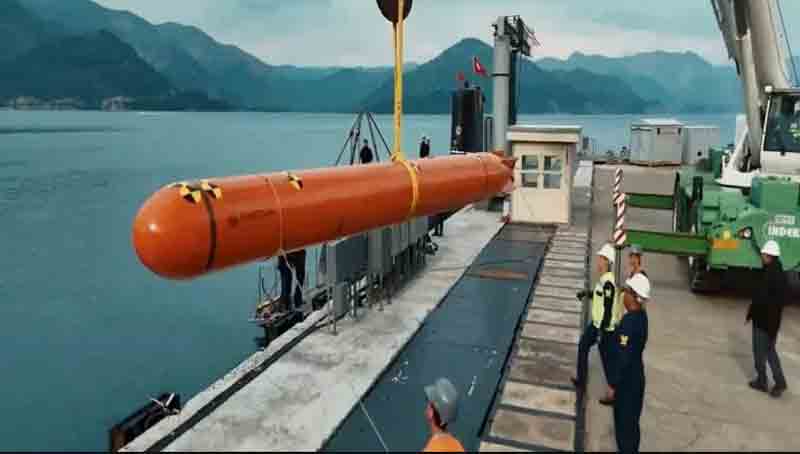In a notable achievement for its naval strike capabilities, the Turkish Navy has successfully executed the inaugural test launch of the submarine-launched version of the ATMACA anti-ship missile. This event signifies a substantial leap forward in the nation’s indigenous defense technology.
The successful trial highlights Türkiye’s increasing proficiency in developing and deploying next-generation maritime strike systems, thereby bolstering its strategic deterrence and operational capabilities.
The landmark test launch occurred in the eastern Mediterranean Sea from the Turkish Navy’s Type 209/1400 diesel-electric attack submarine, TCG Preveze (S-353), which has been extensively modernized to incorporate advanced combat and weapon systems.
The submarine-launched ATMACA adds a new facet to Türkiye’s undersea warfare strategy, enabling its submarines to engage enemy surface vessels from extended ranges while preserving acoustic stealth. Unlike traditional torpedo attacks that necessitate submarines to approach their targets closely, this long-range capability allows Turkish submarines to conduct precise strikes from hidden positions, significantly complicating the defensive measures of adversaries.
The successful test was officially announced by Prof. Haluk Görgün, President of the Turkish Defence Industries Secretariat (SSB), through the social media platform X (formerly Twitter), underscoring Türkiye’s advancements toward achieving self-reliance in high-end naval weaponry.
The missile was launched utilizing the advanced Müren Combat Management System (CMS), a state-of-the-art digital battle network aimed at improving situational awareness, targeting precision, and coordination among multiple weapons. The Müren CMS was incorporated into TCG Preveze during its Mid-Life Upgrade (MLU) program, ensuring that Türkiye’s older submarines remain effective against changing maritime threats.
In contrast to its ship-launched version, the submarine-launched ATMACA is housed in a specially designed watertight launch canister, which is crafted to be expelled from the submarine’s 533 mm torpedo tubes. This encapsulation technology allows the missile to endure the significant pressures encountered during deep-sea operations before surfacing to commence its engagement sequence.
Once launched, the capsule propels itself away from the submarine, reducing both acoustic and thermal signatures prior to the missile’s activation and release, thereby facilitating a stealthy, long-range strike against enemy vessels. The ATMACA missile measures between 4.8 and 5.2 meters in length and weighs less than 800 kilograms. It is equipped with a 250-kilogram high-explosive, penetration-type warhead, specifically designed to breach the heavily armored hulls of warships and detonate internally for maximum destructive impact.
ATMACA boasts an impressive range of over 220 kilometers, specifically engineered for stealthy, high-precision attacks on enemy naval forces. The development of the ATMACA anti-ship missile project began in 2009, led by ROKETSAN, which was responsible for creating the missile’s airframe and propulsion system.
In parallel, ASELSAN contributed by designing the sophisticated radio frequency (RF) seeker and precision guidance system, while Kale Arge provided the missile’s high-performance engine. After its inaugural land-based test launch in 2017, ATMACA was successfully launched from a warship for the first time in November 2019, when it was fired from TCG Kınalıada, the fourth Ada-class (MILGEM) corvette of the Turkish Navy, in the Black Sea.
A significant achievement occurred in February 2021, when ATMACA was tested with a live warhead, confirming its operational effectiveness in actual combat scenarios. Presently, ATMACA is the primary anti-ship missile for the Turkish Navy, gradually replacing the long-serving American-made Boeing RGM-84 Harpoon, which has been a cornerstone of Türkiye’s naval strike capabilities for many years. The missile is currently deployed on Ada-class corvettes and is being integrated into the Barbaros-class frigates as part of their mid-life upgrade (MLU) program, ensuring that Türkiye’s naval surface fleet is equipped with state-of-the-art strike capabilities.
The ATMACA anti-ship missile has swiftly attracted global interest, presenting itself as a cost-effective yet highly proficient alternative to Western missile systems like the Harpoon, Exocet, and NSM (Naval Strike Missile).
Indonesia and Malaysia, two significant maritime nations in Southeast Asia, are among the first to export customers, seeking advanced naval capabilities at a reasonable price.
In November 2022, Indonesia finalized a deal to acquire 45 ATMACA missiles, enhancing its naval deterrence amid escalating maritime security challenges in the region. Malaysia has also opted for the ATMACA missile system, intending to incorporate it into its forthcoming three Littoral Mission Ship (LMS) Batch 2 vessels, which are based on the Turkish Ada-class corvette design. This decision is part of Malaysia’s broader naval modernization strategy, focused on strengthening coastal defense and blue-water operations.
The successful development and testing of the submarine-launched ATMACA marks a significant milestone for Türkiye’s defense industry, placing it among a select group of nations capable of producing and deploying advanced submarine-launched missile systems.
As the Turkish Navy enhances its underwater warfare capabilities, the ATMACA will act as a force multiplier, broadening the operational range of Türkiye’s submarine fleet and reinforcing its strategic position in the Mediterranean, Aegean, and Black Sea regions.
The growing global interest in the ATMACA indicates a transformation in naval armament procurement, with non-Western defense manufacturers gaining prominence in the competitive international arena. As Türkiye continues to advance its indigenous defense technology, the ATMACA missile family—now including land, sea, and submarine-launched variants—represents the nation’s increasing defense self-sufficiency and its aspirations to emerge as a global leader in advanced missile systems.
Discover more from Defence Talks | Defense News Hub, Military Updates, Security Insights
Subscribe to get the latest posts sent to your email.





